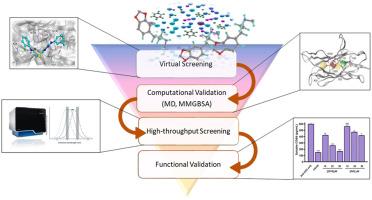基于结构的虚拟筛选识别细胞和粘膜模型中抑制T细胞共刺激的有效CD28抑制剂
IF 5.9
2区 医学
Q1 CHEMISTRY, MEDICINAL
引用次数: 0
摘要
针对PD-1和CTLA-4的免疫检查点抑制剂的耐药性仍然是有效癌症免疫治疗的主要障碍,通常由代偿性cd28介导的共刺激引起。在这里,我们报告了通过基于结构的虚拟筛选管道鉴定的小分子CD28拮抗剂的发现和生物学验证。分子动力学和基于pyrod的水定位揭示了CD28上一个富含药物特征的隐性亲脂峡谷。基于药物团的筛选超过700万种化合物,产生了几种候选化合物,其中化合物22VS是基于生物物理结合(TRIC和MST),结构-活性洞察以及ELISA和NanoBit检测中的功能抑制的先导化合物。22VS显示出有效和选择性阻断CD28-B7相互作用,在细胞检测中具有亚微摩尔IC50值和最小的细胞毒性。重要的是,22VS抑制了人肿瘤- pbmc和粘膜- pbmc共培养系统中的促炎细胞因子(IFN-γ, IL-2, TNF-α),密切模仿靶向cd28的生物FR104的生物活性。药代动力学分析显示,在人成纤维细胞中具有良好的溶解性、代谢稳定性、低CYP抑制和良好的安全性。这些发现确立了CD28作为可药物免疫治疗检查点的地位,并验证了22VS作为调节T细胞反应的有希望的主要候选药物。这种小分子方法提供了一种可行的药理学策略来克服与PD-1和CTLA-4阻断相关的耐药机制,对自身免疫性疾病、移植和癌症免疫治疗具有重要意义。本文章由计算机程序翻译,如有差异,请以英文原文为准。


Structure-based virtual screening identifies potent CD28 inhibitors that suppress T cell co-stimulation in cellular and mucosal models
Resistance to immune checkpoint inhibitors targeting PD-1 and CTLA-4 remains a major barrier to effective cancer immunotherapy, often arising from compensatory CD28-mediated costimulation. Here, we report the discovery and biological validation of small molecule CD28 antagonists identified through a structure-based virtual screening pipeline. Molecular dynamics and Pyrod-based water mapping revealed a cryptic lipophilic canyon on CD28 enriched in druggable features. A pharmacophore-based screen of over 7 million compounds yielded several candidates, of which compound 22VS emerged as a lead based on biophysical binding (TRIC and MST), structure–activity insights, and functional inhibition in ELISA and NanoBit assays. 22VS demonstrated potent and selective blockade of CD28–B7 interactions, with submicromolar IC50 values in cellular assays and minimal cytotoxicity. Importantly, 22VS suppressed proinflammatory cytokines (IFN-γ, IL-2, TNF-α) in human tumor–PBMC and mucosal–PBMC co-culture systems, closely mimicking the biological activity of the CD28-targeting biologic FR104. Pharmacokinetic profiling revealed favorable solubility, metabolic stability, low CYP inhibition, and excellent safety in human fibroblasts. These findings establish CD28 as a druggable immunotherapeutic checkpoint and validate 22VS as a promising lead candidate for modulating T cell responses. This small-molecule approach offers a viable pharmacological strategy to overcome resistance mechanisms associated with PD-1 and CTLA-4 blockade, with implications for autoimmune disease, transplantation, and cancer immunotherapy.
求助全文
通过发布文献求助,成功后即可免费获取论文全文。
去求助
来源期刊
CiteScore
11.70
自引率
9.00%
发文量
863
审稿时长
29 days
期刊介绍:
The European Journal of Medicinal Chemistry is a global journal that publishes studies on all aspects of medicinal chemistry. It provides a medium for publication of original papers and also welcomes critical review papers.
A typical paper would report on the organic synthesis, characterization and pharmacological evaluation of compounds. Other topics of interest are drug design, QSAR, molecular modeling, drug-receptor interactions, molecular aspects of drug metabolism, prodrug synthesis and drug targeting. The journal expects manuscripts to present the rational for a study, provide insight into the design of compounds or understanding of mechanism, or clarify the targets.

 求助内容:
求助内容: 应助结果提醒方式:
应助结果提醒方式:


